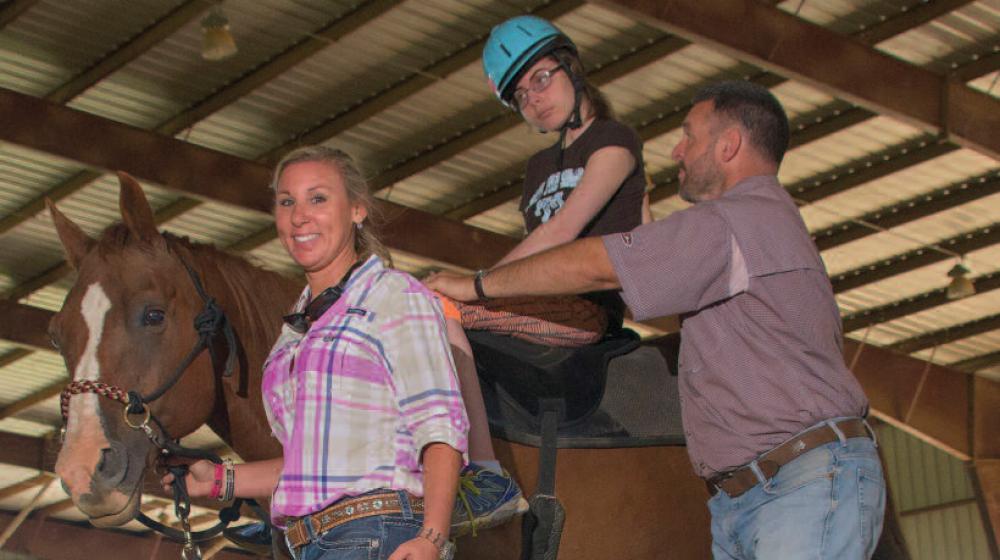Everlasting Therapy

Trauma survivor benefits from Extension hippotherapy program
General outpatient therapy is a major step in helping trauma victims on the road to recovery, but hippotherapy has emerged as an effective method of helping them regain mobility over time.
A new program offered through the MSU Extension Service’s Equine Assisted Therapy is now providing advanced, specialized therapy to patients with brain and spinal injuries who are working to redevelop muscular and neurological functions.
Tupelo native Andi Webb is one of six patients who benefit from weekly horse riding sessions during fall and spring semesters at MSU. A car accident in December 2009 left her in a coma for six months. She was diagnosed with an anoxic injury—permanent brain damage caused by an extended lack of oxygen.
Webb’s original prognosis was a life expectancy of five years or less with no chance of regaining consciousness, but a second evaluation from the Shepherd Clinic in Atlanta showed more promise for recovery. She returned home in April 2010 after spending two months there. Once a singer in her church choir, she emerged from her coma during a service on Mother’s Day. Her mother, Sherry, was by her side at the time.
“She started singing,” Sherry Webb says. “She knew every word to every song.”
Outpatient speech and occupational therapy followed for the next five years. During that time, Andi made strides forward, but her mother says her progress eventually stalled, which prompted her to search for another outlet. She found one in Extension’s emerging hippotherapy program.
Hippotherapy is different from therapeutic horseback riding. Therapeutic riding teaches riding skills as a means of treatment for people with intellectual, emotional, psychological, and/or physical disorders. In hippotherapy, however, participants sit astride the horse and gain physical strength by responding to its movements.
Program coordinator Cassie Brunson, physical therapist Jackie Parker, and physical therapy assistant Sarah Huerkamp are working together to grow the new program within Equine Assisted Therapy at the Elizabeth A. Howard 4-H Therapeutic Riding and Activity Center, or “TRAC,” in West Point. The hippotherapy component has been consistently offered for more than a year.
“We currently have only three horses that can be used for hippotherapy,” Brunson explains, “because they have to be even more tolerant and patient than the average therapeutic riding horse.”
Sherry Webb says she has seen significant improvement in her daughter’s recovery since she started.
“Andi is in a wheelchair, and her weakness is her right side. Her right leg is weak, and she has no use of her right arm,” Webb says. “Hippotherapy has taught her balance. When she started the program, she was posturing backwards. It took a therapist on either side of her to push her forward just to hold her up on the horse. By the end of the first semester, all they were doing was keeping her from falling off the horse. She was doing everything else herself.”
The first forecasts based on Andi’s early progress after coming out of her coma indicated she would not walk again. Her mother now believes otherwise.
“This therapy stretches and relaxes your body. Her legs were so tight, and she would have to put her knees together just to stand up. Now, she can stand like a normal person,” Webb says. “It’s night and day compared to where she was before she began the therapy. We recently had a prosthetics company have her fitted for braces. I have no doubt she’s going to walk again.”
Hippotherapy requires a physician’s approval, just as therapy services would in an outpatient clinic, and all care providers must be certified. Parker and Huerkamp work one-on-one with each rider to address his or her individual needs.
“What we do is assess Andi’s functional limitations and disabilities, and we match up what we’re trying to accomplish with movements of a horse with the right temperament that can help us get there,” Parker says. “We’ve seen her gain in her balance and strength. Her standing is a lot better and steadier. She has worked on taking some steps, and she’s working her way up to walking. She’s come a long way.”
Whether they are involved with therapeutic riding or hippotherapy, Brunson says each rider has specific needs.
“Every semester, we set goals for each rider to work toward,” Brunson says. “We have children with autism or Down syndrome who are coming for an outlet and for socialization. Andi is coming to regain the strength she once had. Everybody is working toward completely different goals, and one of the most important parts of our jobs is identifying what those goals are.”
Webb says Andi’s favorite horse is Fred, an 18-year-old quarter horse who has been with the program for almost two years, because of his gentle nature.
“Hippotherapy is amazing because there is no limit on it. It is an everlasting therapy,” Webb says. “Every time Andi goes, she’s high-spirited. She loves to laugh, joke, and have fun with them. It’s like a birthday party for her every time she gets to go. We would have been sitting at the house trying to figure out what to do if we had not gotten her in this program, because there are no other options for her right now.”


